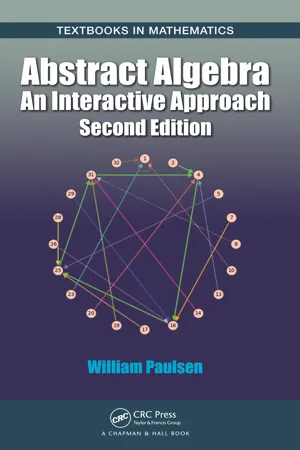
- 619 pages
- English
- ePUB (mobile friendly)
- Available on iOS & Android
About this book
The new edition of Abstract Algebra: An Interactive Approach presents a hands-on and traditional approach to learning groups, rings, and fields. It then goes further to offer optional technology use to create opportunities for interactive learning and computer use.
This new edition offers a more traditional approach offering additional topics to the primary syllabus placed after primary topics are covered. This creates a more natural flow to the order of the subjects presented. This edition is transformed by historical notes and better explanations of why topics are covered.
This innovative textbook shows how students can better grasp difficult algebraic concepts through the use of computer programs. It encourages students to experiment with various applications of abstract algebra, thereby obtaining a real-world perspective of this area.
Each chapter includes, corresponding Sage notebooks, traditional exercises, and several interactive computer problems that utilize Sage and Mathematica ® to explore groups, rings, fields and additional topics.
This text does not sacrifice mathematical rigor. It covers classical proofs, such as Abel's theorem, as well as many topics not found in most standard introductory texts. The author explores semi-direct products, polycyclic groups, Rubik's Cube®-like puzzles, and Wedderburn's theorem. The author also incorporates problem sequences that allow students to delve into interesting topics, including Fermat's two square theorem.
Frequently asked questions
- Essential is ideal for learners and professionals who enjoy exploring a wide range of subjects. Access the Essential Library with 800,000+ trusted titles and best-sellers across business, personal growth, and the humanities. Includes unlimited reading time and Standard Read Aloud voice.
- Complete: Perfect for advanced learners and researchers needing full, unrestricted access. Unlock 1.4M+ books across hundreds of subjects, including academic and specialized titles. The Complete Plan also includes advanced features like Premium Read Aloud and Research Assistant.
Please note we cannot support devices running on iOS 13 and Android 7 or earlier. Learn more about using the app.
Information
Table of contents
- Cover
- Half Title
- Title Page
- Copyright Page
- Table of Contents
- List of Figures
- List of Tables
- Preface
- Acknowledgments
- About the Author
- Symbol Description
- Introduction
- 2 The Structure within a Group
- 3 Patterns within the Cosets of Groups
- 4 Mappings between Groups
- 5 Permutation Groups
- 6 Building Larger Groups from Smaller Groups
- 7 The Search for Normal Subgroups
- 8 Solvable and Insoluble Groups
- 9 Introduction to Rings
- 10 The Structure within Rings
- 11 Integral Domains and Fields
- 12 Unique Factorization
- 13 Finite Division Rings
- 14 The Theory of Fields
- 15 Galois Theory
- Appendix: Sage vs. Mathematical®
- Answers to Odd-Numbered Problems
- Bibliography
- Index